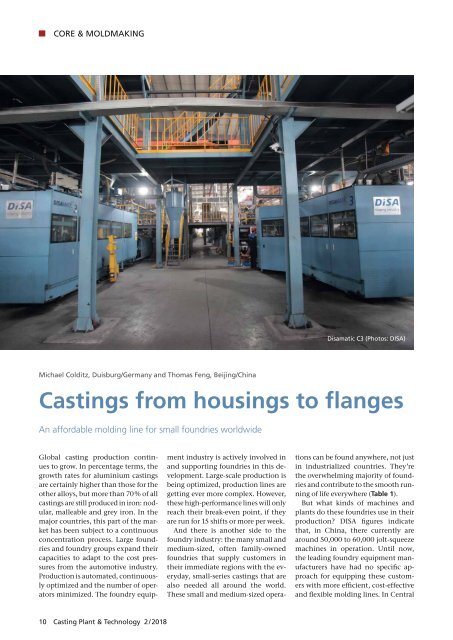CPT International 02/2018
- No tags were found...
You also want an ePaper? Increase the reach of your titles
YUMPU automatically turns print PDFs into web optimized ePapers that Google loves.
CORE & MOLDMAKING<br />
Disamatic C3 (Photos: DISA)<br />
Michael Colditz, Duisburg/Germany and Thomas Feng, Beijing/China<br />
<br />
An affordable molding line for small foundries worldwide<br />
Global casting production continues<br />
to grow. In percentage terms, the<br />
growth rates for aluminium castings<br />
are certainly higher than those for the<br />
other alloys, but more than 70 % of all<br />
castings are still produced in iron: nodular,<br />
malleable and grey iron. In the<br />
major countries, this part of the market<br />
has been subject to a continuous<br />
concentration process. Large foundries<br />
and foundry groups expand their<br />
capacities to adapt to the cost pressures<br />
from the automotive industry.<br />
Production is automated, continuously<br />
optimized and the number of operators<br />
minimized. The foundry equipment<br />
industry is actively involved in<br />
and supporting foundries in this development.<br />
Large-scale production is<br />
being optimized, production lines are<br />
getting ever more complex. However,<br />
these high-performance lines will only<br />
reach their break-even point, if they<br />
are run for 15 shifts or more per week.<br />
And there is another side to the<br />
foundry industry: the many small and<br />
medium-sized, often family-owned<br />
foundries that supply customers in<br />
their immediate regions with the everyday,<br />
small-series castings that are<br />
also needed all around the world.<br />
These small and medium-sized operations<br />
can be found anywhere, not just<br />
in industrialized countries. They’re<br />
the overwhelming majority of foundries<br />
and contribute to the smooth running<br />
of life everywhere ().<br />
But what kinds of machines and<br />
plants do these foundries use in their<br />
production? DISA figures indicate<br />
that, in China, there currently are<br />
around 50,000 to 60,000 jolt-squeeze<br />
machines in operation. Until now,<br />
the leading foundry equipment manufacturers<br />
have had no specific approach<br />
for equipping these customers<br />
with more efficient, cost-effective<br />
and flexible molding lines. In Central<br />
10 Casting Plant & Technology 2 / <strong>2018</strong>


















